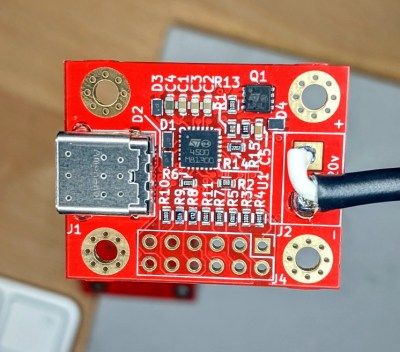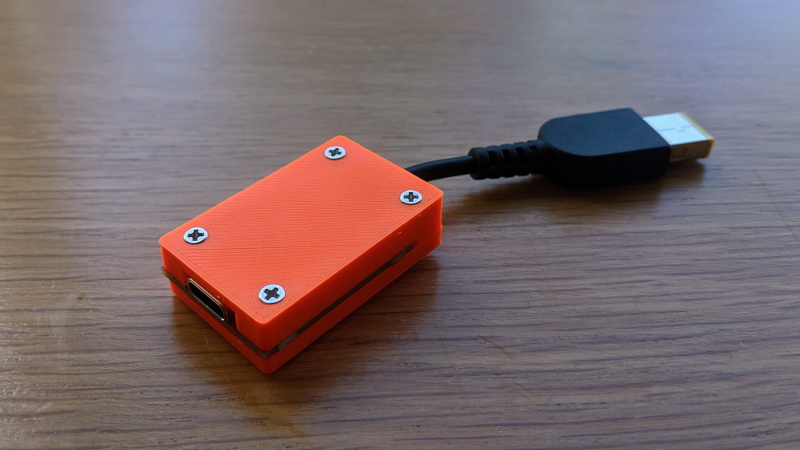The promise of USB Power Delivery (USB-PD) is that we’ll eventually be able to power all our gadgets, at least the ones that draw less than 100 watts anyway, with just one adapter. Considering most of us are the proud owners of a box filled with assorted AC/DC adapters in all shapes and sizes, it’s certainly a very appealing prospect. But [Mansour Behabadi] hasn’t exactly been thrilled with the rate at which his sundry electronic devices have been jumping on the USB-PD bandwagon, so he decided to do something about it.
 [Mansour] wanted a simple way to charge his laptop (and anything else he could think of) with USB-PD over USB-C, but none of the existing options on the market was quite what he wanted. He looked around and eventually discovered the STUSB4500, a a USB power delivery controller chip that can be configured over I2C.
[Mansour] wanted a simple way to charge his laptop (and anything else he could think of) with USB-PD over USB-C, but none of the existing options on the market was quite what he wanted. He looked around and eventually discovered the STUSB4500, a a USB power delivery controller chip that can be configured over I2C.
With a bit of nonvolatile memory onboard, it can retain its settings so he didn’t have to include a microcontroller in his design: just program it once and it can be used stand-alone to negotiate the appropriate voltage and current requirements when its plugged in.
The board that [Mansour] came up with is a handy way of powering your projects via USB-C without having to reinvent the wheel. Using the PC configuration tool and an Arduino to talk to the STUSB4500 over I2C, the board can be configured to deliver from 5 to 20 VDC to whatever device you connect to it. The chip is even capable of storing three seperate Power Delivery Output (PDO) configurations at once, so you can give it multiple voltage and current ranges to try and negotiate for.
In the past we’ve seen a somewhat similar project that used USB-PD to charge lithium polymer batteries. It certainly isn’t happening overnight, but it looks like we’re finally starting to see some real movement towards making USB-C the standard.















“it looks like we’re finally starting to see some real movement towards making USB-C the standard.”
Not so fast! USB-C is great and all but it’s only a stop-gap!
USB-C just can’t supply enough power for all our projects, future and past.
There can be no real long term standard until we get something that can provide 1.21 jigawatts!
I see no point using of USB-C until it can charge electric vehicles.
I want to be able to charge my car battery over USB-C — and in just a few hours.
How often do you end up having to do that?
And how often are you that close to an AC outlet that a power brick would help you?
Not sure the benefit of it being USB-C either — there are plenty of battery charger that are probably $50 at the local walmart.
Wooooosh ;-)
A trolling we will go, a trolling we will go,
High ho the merrio, a trolling we will go!
With USB-C being able to transfer power in both directions, car battery charging has never been easier before!
What you have to do is plug your phone into a USB-C adapter in your car, and then – this is key – you have to say out loud that you want the phone to charge.
Bam! It will hear your request, and out of spite will drain the phone charge into the car battery lickety split.
So get this chip, set it for 12v and enjoy 8 amps of chargjng :)
Or I guess set it for 20v, add a buck style trickle charger (maybe a ‘solar panel’ charge controller. ~5A will put some juice into your battery
Miles, limit is 3A in any mode other than 20V mode and in 20V mode you need an active cable with E-marker and ability to communicate with it to go above 3A.
100W is equivalent to a trickle charger, you won’t be doing any rapid car charging here, better to find some sort of quantum shrubbage and attempt to extract power from that.
If you add one of the many youtube free energy converters to your alternator your set for a while. Eventually you have to replace one of the bearings free energy aint really free.
This is a great power hack.
Great! I had been thinking about a project to take on just like this in a fevered dream last night.
Nice post, interesting shift in power delivery options bound to happen with areas of improved convergence with of course greater variance for “unintended consequences” – worth watching all the air crash investigation documentaries – geesh !
Wonder if we will see higher power AC delivery topologies which include signalling options, eg low current burst serial comms on the mains power ground line eg too low for RCDs ?
Thanks for post :-)
Ever heard of the Cypress EZ-PD Barrel Connector Replacement? Single chip USB PD negotiation IC configurable with resistors. No writing code required. Or even PCB layout, since you can buy one from the manufacturer….
Yup, that’s a good one.
I assume you’re talking about: https://www.cypress.com/documentation/development-kitsboards/cy4533-ez-pd-bcr-evaluation-kit
I hadn’t heard about it nor did I come across it after a good number of google searches. They need to make it more findable.
Also, you can get low quantity (6) boards made for cheaper per unit than this “mass produced” one! It also lacks mounting holes and personally I think it has awkward dimensions and terminal/port placement to work with. It has by default, all the tall components already soldered (which I didn’t want to have) and it also sports components on the bottom of the board, which makes it just a tad more annoying to mount on flat surfaces. All-in-all, had I come across this, I would have still pursued a custom design as it wouldn’t match my requirements. These are of course my preferences and the Cypress board may be good enough for others.
Regarding programming: you still need to program this board if you want fine-grained voltage/current setting.
My biggest hurdle in adopting USB-C PD is the lack of focus on “DIY” things that can deliver the USB-C power delivery from various power sources, rather than using existing USB-C PD devices to power various non USB-C things.
A bit of a chicken & egg situation if you will.
There are plenty of reference designs from the manufacturers for you to adopt it -These have been published on the net since before the introduction of the spec. You need to have a good understanding of power electronics and be able to code to tailor to your specific solution. It’s as ‘DIY’ as it will ever be, the USB specs have grown into something far, far above “maker” level of complexity. Look at Cypress, TI, or On Semi reference designs. Pretty cool.
Cypress had released a new product recently called as BCR (Barrel Connector Replacement) which can power any electronic device up to 100W. The board’s pretty cheap at$25 and it can actually replace all the chargers at home.
Just needs to get more traction.
Humm, I wonder if this is the solution to dying power supplies for classic computers like the c64 or vic20 that had duel 5v and 9v power rails?
5V is possible up to 3A w/o communication and 9V @ 3A with PD 2.0 or 3.0 enumeration. This would be easily possible with a 2 port PD charger but far more complex than bucking 5V and 9V off of a standard 12V power supply. PD is intended for modern devices with very specific power regulation requirements.
Is there a download link for the computer program used for programming the usb c board? If so how do I program it. Do I use a usb c cable?
now we also have this to choose from: https://lygte-info.dk/review/USBmeter%20yzxStudio%20ZY12PDS%20PD%20trigger%20UK.html
smaller and chaper, doesn’t seem to have been featured on hackaday yet
I’m trying to figure out how to split power to charge 2 phones at once with my dewalt charging kit